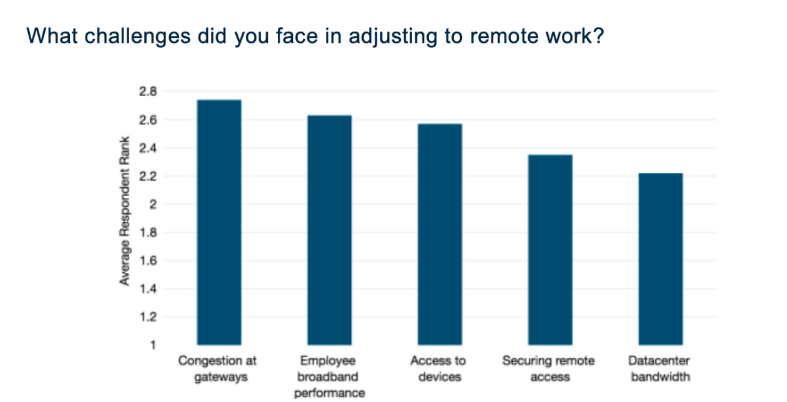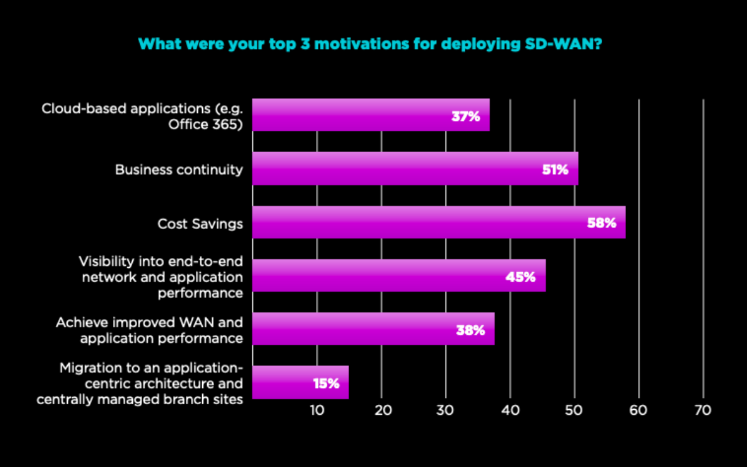A deep-dive into the reasons organisations, such as yours, are adopting SD-WAN, and the benefits they are witnessing.
If you were asked to name the fastest-growing technologies today, it is likely your answers would include artificial intelligence (AI), the Internet of Things (IoT), analytics and blockchain-enabled decentralised finance (De-Fi) and non-fungible tokens (NFTs).
Not a lot of people would put software-defined wide-area networks (SD-WAN) in this category. But that would be unfair.
IDC forecasts that the SD-WAN market will grow 18.9% a year until 2025, making it among the fastest-growing segments of the network market. This growth is driven by incredible adoption rates. According to the 2021 State of SD-WAN Study, “SD-WAN adoption is expected to rise to 92% of companies and 64% of enterprise locations by 2026 with most adopting it for efficiency (38%), cost savings (38%), and agility (34%).”
A Deeper Look at What Is Driving SD-WAN
A confluence of forces—some driven by nature, others by human stakeholders—has produced an SD-WAN tipping point. As an increasing number of enterprises adopt the technology, several industry-watchers have begun to ask whether, in the near future, organisations will even refer to the term SD-WAN, or just merely ‘networks’.
This perfect storm of trends—including real-time applications powered by the trio of 5G, IoT and edge computing; and the need for greater operational resilience driven by uncertain environments and natural disasters—highlight the need for more agile networks. Among the drivers of SD-WAN, there are two stand out: More distributed computing landscapes, and the rise of hybrid workplaces.
“Enterprise applications are more distributed than ever, and now because of COVID-19, the users accessing those applications are more distributed too. As organisations look to support a hybrid workforce and cloud-native network architectures, SD-WAN infrastructure has become a critically important technology for enabling flexible, agile, and optimised connectivity," says Ajeet Das, Research Director, IDC.
Hybrid office configurations are placing a significant amount of pressure on enterprise networks. TeleGeography’s WAN Manager Survey shows that 85% of organisations had the majority of their workforce working remote; with the 80%-20% configuration (80% remote/20% at job sites) being the most popular.
When they looked deeper into the network challenges that these companies faced, the results underscored the need for better network management. (Responses were graded on a scale of 1-5, with 5 representing very challenging).

Source: WAN Manager Survey
Greater adoption of the cloud, too, is pushing organisations to adopt more agile networking strategies such as SD-WAN. In a pre-multi-cloud world, enterprise network operations (NetOps) teams would backhaul traffic from remote locations to data centres. This enabled security operations (SecOps), among other aims, to execute security checks on traffic.
But as more applications reside in the cloud than ever, this strategy introduces congestion, delays, and increased costs. Plus, cloud strategies introduce more dynamism than static traditional network architectures can support—making the network a chokepoint for digital transformation. Virtual machines and containers, for example, can be scaled up, but most networks are not this flexible.
The use of cloud solutions and cloud-native tools is just one facet of digital transformation. As enterprises digitalise every aspect of their business from communication to processes, more data flows are going in more directions. All this activity creates intense pressure on wide area networks (WANs).
Modern enterprises require higher levels of application performance and more simplified management to handle more dynamic, more mixed, and more complex networks. With traditional WANs, the burden on network teams (with operational tasks including provisioning, configuring, monitoring and managing) become untenable, introducing high overhead costs, errors, delays, and poor responsiveness.
Additionally, dedicated, private circuits—a default for many large enterprises—are expensive, have long gestation periods, and require more time and more skills to manage. The complexity problem increases exponentially for global companies, which must address the needs of a large number of geographically-dispersed edge locations, many with limited connectivity options, and constrained by the cost and service variables of region-specific connectivity offerings.
The hard reality is that existing WANs are not geared up to take on the needs of digitally transforming organisations.
The Upside of SD-WAN
SD-WANs can help enterprises solve these challenges. SD-WANs introduce multiple network benefits that span across functions, and dimensions.
For NetOps teams, SD-WAN can improve network sizing. Typically, to ensure that networks are well-provided for, network teams will build in redundancy, such as additional bandwidth. Over time, it becomes difficult to assess whether there is a glut of bandwidth. SD-WAN brings more visibility to the network, which allows network teams to better gauge utilisation and requirements, enabling them to trim provisioning. This increased visibility, and the ability to monitor the WAN enables networks teams stay on top of cost, application performance, and congestion levels, among network health indicators.
Plus, because SD-WAN technology allows networks to use back-up transport layers, instead of activating them only in emergencies, organisations get more value from their network assets, which makes it easier for network leaders to defend purchase decisions.
Lower costs are a significant motivator of adopting SD-WAN. According to the State of the Network 2020, it is the top reason enterprises are embracing SD-WAN, say 58% of respondents.

Source: State of the Network 2020
One of the ways, SD-WANs shrink cost is by enabling different data types (mission-critical vs less-mission critical, for example) to be routed on the most cost-effective underlay. Business applications, which require high quality of service (QoS) and security, for instance, can be
prioritised and delivered using more expensive private circuits, while less critical application data can be routed through more cost-effective public Internet paths. This ability to “prioritise business critical traffic” is also an important benefit of SD-WAN, say 46% of network professionals, points out IDG Research.
Then, there is the resiliency argument. SD-WAN virtualises the network with an overlay which allows network executives to cope more easily with drastic changes—like the COVID-19 pandemic, for example—when network traffic shifts. During the pandemic more applications, and traffic, quickly moved to the cloud. SD-WANs also make it easier and more effective to create failover paths, so that when a primary link is disrupted, data flows switch to another route or transport layer, with insignificant impact on users.
SD-WANs create more choice for network teams. With SD-WANs, network engineers can choose from a greater variety of transport layers, mixing and matching, and creating policy-based priorities for data mediums based on specific QoS, security or cost requirements. SD-WANs allow network managers to add nodes to the network more quickly, allowing them to stay aligned with dynamic and unpredictable business needs. SD-WANs also avoid many of the errors that manually configuring traditional WANs can introduce.
With its ability to centrally orchestrate a network, SD-WANs lower the burden on network teams, increasing their productivity and cost-effectiveness, and ensuring that network policies can be pushed centrally or replicated among edge nodes, which in turn strengthens an organisation’s security posture.
For the business, SD-WAN benefits appear as improvements to application performance, thanks to its ability to adaptatively segment and re-route traffic intelligently. SD-WAN makes it easier to extend the enterprise to the cloud, and the multiple benefits of the cloud. From a profitability point of view, it lowers the cost overheads associated with managing complex networks, such as people and bandwidth. SD-WANs also result in greater business confidence from less downtime, and more agility.
TM WHOLESALE: Supercharging Networks
The more complex and dispersed an enterprise is, the more benefits discussed here apply. For global organisations shifting from more traditional network architectures to SD-WAN, it is important to weigh the costs of an SD-WAN implementation against its benefits. TM WHOLESALE—the global and wholesale business arm of Telekom Malaysia Berhad (TM)—can help assess what SD-WAN can achieve, creating a benefits-based business case.
TM WHOLESALE can also help guide enterprises across the SD-WAN lifecycle from professional services to consult and design a network customised to your business; to fully-managed services that includes sourcing and delivery, proactive monitoring, a 24x7 contact centre and local field support.
TM WHOLESALE offers a host of connectivity types including broadband Internet, dedicated Internet access (DIA), mobile LTE, IPVPN, satellite, and global private meshed backbone. Additionally, it has a BYOC (Bring Your Own Connectivity) option.
To help accelerate adoption, TM WHOLESALE offers Global SD-WAN packages in three flavours: SD-Lite, a cost-effective, Internet-based solution; SD-Pro for businesses which require a mix of private and public links to support both mission-critical and non-core applications; and SD-Flex, an a-la-carte option that for enterprises that need the flexibility of working with existing connectivity contracts.
With TM WHOLESALE, organisations can also add on security services to inspect data, and have access to an analytics portal which offers NetOps teams granular visibility of network health.
Start your network transformation journey with TM WHOLESALE today!








